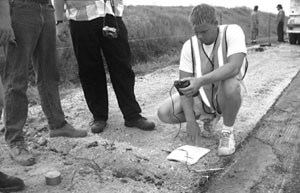U.S. Department of Transportation
Federal Highway Administration
1200 New Jersey Avenue, SE
Washington, DC 20590
202-366-4000
Focus
| Accelerating Infrastructure Innovations |
Publication Number: FHWA-RD-02-015
Date: October 2002
To speed up the reconstruction of the collapsed Interstate 40 bridge in eastern Oklahoma this past summer (see August 2002 Focus), one of the technologies that the Oklahoma Department of Transportation and contractor Gilbert Central Corporation relied upon was the concrete maturity meter. The maturity meter system consisted of sacrificial sensors placed in the concrete to measure temperature and calculate maturity, as well as handheld readers to download data from the sensors. The sensors effectively predicted the in-place concrete strength gain, which allowed the contractor to make decisions on concrete form removal, thereby accelerating the construction schedule.
The maturity method contrasts with conventional testing, which requires concrete beams or cylinders to be tested before making decisions about the readiness of the pavement. The conventional testing is both more expensive and time consuming. Conventional testing also does not represent the increased strength gain of the in-place concrete at early ages. In the case of Oklahoma, where speed was of the essence, the maturity meter system proved to be a valuable tool that contributed to Gilbert Central completing the reconstruction 10 days ahead of schedule.
Although the maturity concept was first proposed in the late 1940s and early 1950s, there was limited use of it over the next 40 years. Interest in the concept significantly revived in the mid 1980s, as the concrete industry and others began looking for ways to accelerate pavement construction and implement high-speed inspection. Over the past 5 years, use of the maturity method has increased dramatically as State highway agencies and industry have become more aware of the technology and the equipment has become more advanced. A survey conducted by the Pennsylvania Transportation Institute in 2000 found that 32 of the 44 States responding had conducted or were currently conducting research on implementation of the maturity concept. Thirteen of the States had a protocol for the use of maturity testing, with the most common use being to predict the concrete strength so as to open the pavement earlier to traffic.
The Iowa Department of Transportation (DOT) has been using maturity meters for nearly 5 years and includes the technology in its standard specifications. The State's contractors have the option of using the maturity method, with virtually all of them adopting the technology. Iowa has found that the method provides a more reliable measurement of when a pavement is ready for use. "Another benefit is that maturity meters measure temperature and thereby strength in real world conditions instead of lab settings," says Jim Grove of Iowa DOT. "Concrete maturity meters are an excellent technique."
Jim Cable of Iowa State University notes that the maturity method can save 3 to 4 weeks on some projects. "Maturity meters allow projects to move forward as soon as possible. After the pavement has been constructed, the meters allow crews to begin work on sawing joints and placing shoulders sooner," he says. "Maturity meters have been one of the easiest technologies to get people to use in Iowa. Most all of the State projects in Iowa involve the use of the maturity method and very few contractors in Iowa perform State or county jobs without using maturity meters."
The Texas Department of Transportation's (TxDOT) Dallas District introduced maturity meters in 1995 and has since used them on both structures and pavements. "Maturity meters are a time saver," says James Hill of TxDOT. "The typical wait of some structures to mature has been cut 2-4 days. This allows bridges to be open sooner, saving both money and time." Use of the meters on a project on State Highway 66 allowed TxDOT to pour the structure's columns and then 2 days later pour the caps, rather than waiting the usual 7 days. Hill notes, however, that the use of the meters requires strict quality control at concrete plants.
 |
| A maturity meter device in Iowa is read before it is covered by concrete. |
 |
| The maturity probe is placed in the concrete slab. |
Advances in maturity meter technology and shared State success stories have increased the popularity of the devices. The Federal Highway Administration's (FHWA) Mobile Concrete Laboratory (MCL) has played a major role in sharing these success stories and working with State highway agencies to implement the maturity method (see February 2001 Focus). The MCL has promoted the use of the maturity concept and other nondestructive testing techniques for over 15 years to more than 30 State highway agencies ranging from Virginia to California.
There have been several significant changes in maturity techniques in recent years, with options ranging from simple thermometers placed in the concrete to microprocessor-controlled dataloggers to wireless transmission of the data directly to construction staff. This information can now be used to immediately alert project staff to temperature-related events in the concrete, such as freezing or elevated curing temperatures. Models can even be incorporated into the system to forecast the future strength of the concrete for scheduling and decision-making purposes.
Looking to the future, the next step will involve using maturity meters to monitor the maturity or strength of concrete in real time, with information available 24/7 at a central office. "This will allow decisions to be made more effectively for opening newly constructed pavements, patches, or overlays much faster than in the past, thereby saving the contractor construction time and reducing the traffic congestion due to lane closures," says Gary Crawford of FHWA.
For more information on maturity meters or the MCL's services, contact Gary Crawford at FHWA, 202-366-1286 (fax: 202-493-2070; email: gary.crawford@fhwa.dot.gov), or Leif Wathne at FHWA, 202-366-1335 (fax: 202-493-2070; email: leif.wathne@fhwa.dot.gov). For a schedule of the lab's upcoming visits, see below.
For more information on Iowa DOT's experiences with maturity meters, contact Jim Grove at Iowa DOT, 515-239-1848 (email: jim.grove@dot.state.ia.us) or Jim Cable at Iowa State University, 515-294-2862 (email: jkcable@iastate.edu). For more information on TxDOT's projects, contact James Hill at TxDOT, 469-371-0649 (fax: 972-772-4879).
|
2002/2003 Mobile Concrete Lab Schedule Note: This schedule is tentative and is subject to change. November 2002 - Bridge project in Washington, DC December 12-13, 2002 - Texas Concrete Pavement Conference Spring 2003 - Peformance-related specification paving project in Florida March 2003 - National Highway Institute materials course training, location to be determined April 2003 - Paving project in New Mexico April/May 2003 - Paving project in New York State Spring/Summer 2003 - Field testing for mixture evaluations for high-performance concrete bridges on I-99 in Pennsylvania |